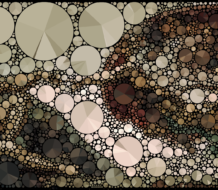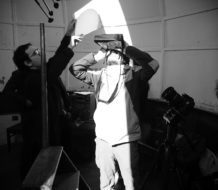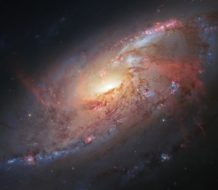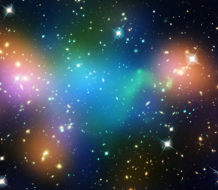Imagine a planet encrusted with ice, beneath which a vast ocean lies. (Imagine Europa.)
Within that ocean a species of brilliant fish evolved. Those fish were so intelligent that they took up physics, and formulated the laws that govern motion. At first they derived quite complicated laws, because the motion of bodies within water is complicated.
One day, however, a genius among fish, call her Fish Newton, had a startling new idea. She proposed fundamental laws of motion––Newton’s laws––that are simpler and more beautiful than the laws the fish had derived directly from experience. She demonstrated mathematically that you could reproduce the observed motions from the new, simpler laws, if you assume that there is a space-filling medium that complicates things. She called it Ocean.
Of course our fish had been immersed in Ocean for eons, but without knowing it. Since it was ever-present, they took it for granted. They regarded it as an aspect of space itself––as mere emptiness. But Fish Newton invited them to consider that they might be immersed in a material medium.
Thus inspired, fish scientists set out to find the atoms of Fish Newton’s hypothetical medium. And soon they did!
That story is our own. We humans, like those fish, have been living within a material medium for millennia, without being consciously aware of it.
The first inkling of its existence came in the 1960s. By that time physicists had devised especially beautiful equations for describing elementary particles with zero mass. Nature likes those equations, too. The photons responsible for electromagnetism, the gravitons responsible for gravity, and the color gluons responsible for the strong force are all zero mass particles. Electromagnetism, gravity, and the strong force are three of the four fundamental interactions known to physics. The other is the weak force.
A problem arose, however, for the W and Z bosons, which are responsible for the weak force. Though they have many properties in common with photons and color gluons, W and Z bosons have non-zero mass. So it appeared that one could not use the beautiful equations for zero mass particles to describe them. The situation grew desperate: The equations for particles with the properties of W and Z, when forced to accommodate non-zero mass, led to mathematical inconsistencies.
The right kind of cosmic medium could rescue the situation, however. Such a medium could slow down the motion of W and Z particles, and make them appear to have non-zero mass, even though their fundamental mass––that is, the mass they would exhibit in ideally empty space––is zero. Using that idea, theorists built a wonderfully successful account of all the phenomena of the weak interaction, fully worthy to stand beside our successful theories of the electromagnetic, strong, and gravitational interactions. Our laws of fundamental physics reached a qualitatively new level of completeness and economy.
The predictions of those “medium-based” laws got tested with the sharpest precision and in the most extreme conditions that experimenters could devise. They were eager to disprove them. The Swedish Academy of Sciences gives prizes for things like that! But the laws passed every test, with flying colors. This grand synthesis has been so successful, for so long, that it has become known as the Standard Model.
Of course, the success of the Standard Model gave circumstantial evidence for the cosmic medium it relies on. Nevertheless, until a few months ago a nagging question remained: What is that cosmic medium made from? No known particles had the right properties.
On July 4, 2012, scientists at the CERN laboratory, near Geneva, announced the discovery of a new particle that seemed as though it might have the required properties. Over the last few months, more detailed measurements have confirmed and sharpened the initial discovery. Several tough consistency checks came in positive. In March CERN declared victory. The main building block of our cosmic Ocean, the Higgs particle, has been successfully identified.
Why does it matter?
The discovery of the Higgs particle is, first and foremost, a ringing affirmation of fundamental harmony between Mind and Matter. Mind, in the form of human thought, was able to predict the existence of a qualitatively new form of Matter before ever having encountered it, based on esthetic preference for beautiful equations.
We plumb the depth of that Mind-Matter harmony if we meditate on the challenge the Higgs particle discovery posed.
The Higgs particle is heavy, couples poorly to matter, and is extremely unstable. (Its lifetime is much too short to be measured directly, but is inferred to be roughly 10-22 sec.) To produce it, scientists had to plan, and then build, the Large Hadron Collider, or LHC. That machine is an extraordinary feat of engineering. The main ring, which houses counter-circulating beams of extremely energetic protons, is 27 kilometers around. The protons are moving at very nearly the speed of light, so they make the circuit about 10,000 times per second. Their paths must be controlled very accurately, using powerful, precisely machined, superconducting magnets. Superconductivity requires low temperatures, so the ring is held at just 2 degrees above absolute zero. Even intergalactic space, filled with the 2.7 degree microwave background, is hotter than that. Thus the LHC ring is the coldest extended region in the universe, unless of course some extraterrestrial civilization is doing similar tricks.
The proton beams are made to cross at a few points, where collisions can occur. The collisions are violent encounters. They reproduce densities of energy achieved when the universe was a mere microsecond old, close to the Big Bang. They make Little Bangs, from which hundreds of energetic particles emerge. Less than one collision per billion contains a Higgs particle. And those that do, don’t come labeled “Higgs particle here!” Far from it. As I mentioned previously, the Higgs particle is extremely unstable. One sees only the products of its decay. From those remnants––which, remember, are delivered mixed up with lots of other debris––one must reconstruct what happened well enough to identify the Higgs.
From this description, I hope you’ll get the (correct) impression that the discovery of the Higgs particle built upon, and required, a tremendous foundation of prior knowledge. We relied on our mathematical equations to guide us in building the machine and to anticipate, in quantitative detail, 99.9999999 percent of what would happen when it ran, so we could concentrate on the interesting novelties. Our equations proved up to the task! This is profound testimony that Mind, in its mathematical productions, accurately reflects the system Matter lives by.
Confirmation of the idea that we live in a cosmic medium has two other, more specific philosophical consequences, as well.
We have learned that some of the observed peculiarities of elementary particles can be blamed on the cosmic medium they inhabit. We can work creatively with beautiful equations that seem to be––and that, taken literally, actually are–– “too good for this world” by imagining a simpler, emptier world where they hold, and devolving from there to here. Can we take that strategy further? Might most––or all?––of the apparent differences among elementary particles be due to the complicating influence of other cosmic media, made from heavier and more elusive Higgs-like particles?
Physicists have taken up that imaginative opportunity, with gusto. We can construct specific, attractive models whose basic equations obliterate the distinctions among strong, weak, and electromagnetic forces. These unified theories go well beyond the Standard Model. They predict the existence of new particles and forces, which could well be discovered within a few years, after the LHC is upgraded to run at higher energies. They are credible, because they also predict quantitative relationships among the observed forces that agree with existing measurements. Specifically, they predict the relative strengths of the strong, weak, and electromagnetic interactions, which are free parameters with the Standard Model itself. In this way, Einstein’s vague dreams of unification have begun to take on tangible, quantitative form.
The other implication is cosmological. Given that we live in a material medium, it is natural to ask whether that medium might change with time, or might have different properties elsewhere — just as our standard analogue, water, can boil into steam, or freeze into ice. Indeed, calculations show that the Higgs-particle medium that fills our universe today could not persist at arbitrarily high temperatures. It is like a liquid that “boils away.” Then the W and Z bosons lose their masses, and the operative laws of physics look different! That almost certainly occurred, during the earliest moments of the Big Bang.
Cosmologists have taken up these imaginative opportunities, also with gusto. Although the cosmic phase transition associated with the (now) known Higgs-particle medium was probably tame, other transitions of that sort could have had dramatic consequences. In particular, they might trigger periods of extremely rapid expansion––cosmic inflation. That has proved to be an extremely fruitful idea in early-universe cosmology.
Space-filling media with variable properties also encourage speculations that the laws of physics might operate quite differently in different locations. There is presently no direct evidence for any effect of that kind, but an inhomogeneous Multiverse is a logical possibility that no longer seems entirely fanciful.
In conclusion, coming back to Earth, I’d like to mention an aspect of the discovery I can only describe as moral. The scientific work leading to the Higgs particle discovery involved thousands of engineers and physicists, not to mention billions of taxpayers, from all over the world co-operating to pursue a common goal. For most of the highly gifted participants, it involved long, often frustrating and sometimes tedious labor, with modest prospects for personal reward. They did it, anyway, because they wanted to understand the world better, and to be part of something great. They did, and they were. In this we have seen, I think, an example of humanity at its best.
Discussion Questions:
- Can you imagine some works of art, or events, that would add to our appreciation of these discoveries? Music? Multimedia? Performances? Installations?
- What does the beauty of the fundamental laws––which everyone who understands them senses––mean? Is it a lucky accident, a trick of perception, or something deeper?
- Do the achievements of CERN, and of the scientific research enterprise in general, provide a model for creative human cooperation that we can build on, to address other, more immediate problems?
Discussion Summary
I’d like to thank my correspondents for their thought-provoking comments and questions. It was a mind-stretching exercise, I hope, for all of us.
The bulk of our discussion revolved around specific scientific issues; in addition, we had some important exchanges about the intelligibility and lawful beauty of the physical world, and its broader philosophical implications. I think the comment thread makes an interesting and valuable document in itself. Since its structure is transparent and user-friendly, I don’t feel it is necessary to append a conventional summary. Instead, I’ll take this opportunity to mention two important issues that might have, but didn’t, rise to the surface. Each will elicit a new Big Question.
In 1929 the great quantum physicist Paul Dirac declared:
The underlying physical laws necessary for the mathematical theory of a large part of physics and the whole of chemistry are thus completely known.
The physical laws Dirac had in mind were Einstein’s general relativity theory, and especially the newly minted theory of quantum electrodynamics. At that time there was only a crude theory of atomic nuclei, but by the mid-1970s physicists developed excellent descriptions of that domain – the realm of the strong and weak interactions – as well. As I mentioned in my essay, the laws have been
… tested with the sharpest precision and in the most extreme conditions that experimenters could devise. They were eager to disprove them. The Swedish Academy of Sciences gives prizes for things like that! But the laws passed every test, with flying colors. This grand synthesis has been so successful, for so long, that it has become known as the Standard Model.
Those tests go far beyond what is necessary for practical purposes of chemistry (including biochemistry), materials science, geology, or even astrophysics. In other words, we now have complete, reliable equations supplying foundations for those subjects. In that strong sense, Newton’s grand program of Analysis and Synthesis has been, on the Analysis side, successfully completed. For practical purposes, Nature has spoken, and we’ve got the message. Heroes of physics including Galileo, Kepler, Newton, Faraday, Maxwell and Planck sincerely considered their endeavor as the exploration of God’s handiwork, or of God’s mind. Einstein and Hawking expressed similar sentiments. From that perspective, I think it is fair to say that we’ve deciphered the language of God.
What is that language? Galileo anticipated its character:
Philosophy [nature] is written in that great book which ever is before our eyes — I mean the universe — but we cannot understand it if we do not first learn the language and grasp the symbols in which it is written. The book is written in mathematical language, and the symbols are triangles, circles and other geometrical figures, without whose help it is impossible to comprehend a single word of it; without which one wanders in vain through a dark labyrinth.
Its ultimate expression, however, involves concepts far richer, and stranger, than triangles, circles, or anything Galileo could have imagined.
The laws are essentially mathematical in form, and they claim universal validity. At no point do they invoke the intervention of intelligent agents. Thus they neither need nor suggest the possibility of “miracles” in a crude sense. Yet in themselves they embody a truly profound miracle: Mind (indeed, human minds) can map Matter faithfully onto a pattern of beautiful ideas.
Big Question 1: What spiritual messages do the weird and wonderful laws that govern the physical world convey?
At the end of my essay, I briefly discussed the search for the Higgs particle, and the larger LHC project, as moral achievements. They exemplify, I think, William James’ concept of “the moral equivalent of war.”
War and military competition, historically, have been major engines of innovation. Leonardo da Vinci applied to potential patrons not only as an artist, but primarily as a military engineer. Several of Leonardo’s most original inventions were engines of war, anticipating modern machine guns, tanks, and helicopters.
In the United States, Cold War anxieties inspired enormous emphasis on science education and investment in research. They also triggered the “space race”, opening an era of vigorous exploration. I myself benefited from this national striving, as I got an excellent start in science in our New York City public schools, and felt secure in the support, both financial but especially psychological, of the surrounding culture.
The fear of enemies and the desire for conquest can motivate intense, selfless effort. Today, in the absence of such obviously fearsome, technologically advanced enemies as the old Soviet Union, support of scientific education and research has become a lesser priority. That is a pity, because great opportunities, both for useful products and for glorious “non-economic” achievements, are being neglected. (The Higgs particle might have been discovered a decade or more ago, and in the U.S., had we not cancelled our version of the LHC – the superconducting supercollider, or SSC – midway through construction.)
Big Question 2: How can we mobilize for an intense “moral equivalent of war,” making Ignorance the enemy?












Some scientists do believe that the universe is billions of years old, yet so many other well-known scientists don’t; believing that it is only about six thousand years old? Whatever happened to the good debate and conclusive facts? So now some scientists have chosen to climb the mountain being today almost at its Zenith where the right minded believers are, and speak of a god particle.
What does the beauty of the fundamental laws––which everyone who understands them senses––mean? Is it a lucky accident, a trick of perception, or something deeper?
Energy moves in the direction of a source according to the fundamental laws. The depth of the matter is the motion.
“They [proton beams generated by the Large Hadron Collider] reproduce densities of energy achieved when the universe was a mere microsecond old, close to the Big Bang. They make Little Bangs …”
Let’s hope they remain “Little Bangs” so we don’t inadvertently disintegrate planet Earth while in pursuit of beautiful fundamental laws.
Has anyone else ever wondered if in the end physics will reveal that the Universe and everything in it right down to “elementary particles with zero mass” (A particle of what? Is such a “particle” merely a zero-dimensional location like a “point” in geometry?) are continually held in existence by an omnipotent will, and all creation actually has “zero mass,” its being in essence a divine thought?
Q: What does the beauty of the fundamental laws––which everyone who understands them senses––mean? Is it a lucky accident, a trick of perception, or something deeper?
Something deeper….
We are not only – through this extraordinary, collective human enterprise – demonstrating our passion and creative capacity as humans, but are also delving into the fundamentals of metaphysics, and the nature of the relationship between Being and Reality. As physical creatures born out of this cosmic soup of “invisible materiality” – non-zero particles, we’ve discovered that human perception, while controlled by psychological (physical) conditioning, is still capable of pushing beyond this constrained envelope of materiality, into abstract thought. CERN is not the only example of the rapidly expanding ‘evolution’ of consciousness, but, it occurs to me that CERN’s discoveries – of these “fundamentals,” ultimately will also provide the key as to how external experience in/of the material realm, mirrors perception… and that the instability of matter may become our way out of the protracted problems we perceive as obstacles.
The beauty of the fundamental laws of physics is rooted in the support it gives to the hope that the universe is intelligible. The Big Bang, the fine-tuning of the coupling constants of physics, the origin of life, and the evolution of microscopic organisms into whales and elephants in a billion years is evidence to the contrary. Added to this is the four-fold structure of the human mind: observing, inquiring, deciding what is true, and controlling our bodies and our inability to define consciousness, intelligence, rationality, and responsibility. We ignore this by saying humans are finite beings and embodied spirits. We ignore the possibility that the universe is not intelligible and assume that an infinite being exists. Western religions call the infinite being God.
How does the discovery of this particle dovetail with,or help elucidates the “quantum entanglement “phenomenon ?Dark energy?Dark matter?– A metaphysical question -What could one infer by a “purposeless “, “unconscious ” Universe causing(or allowing) ,by a “random”process(at the origin), then by natural selection ,the emergence of a conscious being(a part) who endeavors to understand the whole, and does so by the use of ,what we humans call logic( deduction,inference to the best explanation)? Can we thus infer, without a smidgen of credulity , that our universe is conscious ? If we live in a Multi-verse of infinite parts,and by the luck of the draw some proportion of these Universes(a fraction of infinity is infinite ) have laws allowing life , then does this Sea of Higgs Particles engulf the Multi-verse?Does this discovery add any evidence to support the hypothesis ,that these infinite Universes ,at some level, interfere,or are entangled and thus lend support to the existence of “Quantum computers” or conscious communication between these entities?
Hello!
Thanks for your interest in discussing a broad range of issues that the Higgs particle discovery highlights.
To start with I will respond briefly to each comment. If that becomes impractical or repetitious, I’ll switch to a different approach in future entries.
Minister Halsey, in “Debate and Defend”, raises the issue of the age of the universe.
There are many ways used in science to establish the age of objects or to date events. They include studies of changes in isotopic abundances (radiometric dating), cosmological measurements reconstructing the history of the universe, studies of mutation rates and accumulated genetic differences, and others. These methods are well documented in a vast literature. The Wikipedia articles
en.wikipedia.org/wiki/Radiometric_dating,
en.wikipedia.org/wiki/Age_of_the_universe,
en.wikipedia.org/wiki/Molecular_clock
provide basic introductions and links for further information. There are many checks of the methods. For example, radiometric dating can be done using several different isotope combinations, and one can check whether the different measurements yield the same date.
I think it is fair to say – summarizing the vast literature -that these methods have given a richly detailed, extensively checked, and entirely consistent account of the large-scale evolution of the universe (big bang cosmology) and the broad outlines of the geological and biological history of Earth. It is simply not correct to portray these results as being controversial, or as being reached without careful consideration. On the contrary, they are a firm scientific consensus, based on thousands of rigorous investigations and vigorous debates over many decades. One does not serve faith or scripture well, by denying that fact.
Minister Healy also brief mentions scientists speaking of a “god particle”. Here I share his disapproval. The phrase “God Particle” was introduced by Leon Lederman, a famous and very accomplished physicist, in a book about the search for the Higgs particle, presumably as a way to get attention and sell the book. Unfortunately, it’s caught on with journalists and popularizers. It is not a term that’s used in the scientific literature, and theology played no role in the theoretical proposal or experimental discovery of the Higgs particle. It’s just silly, and in my piece I strictly avoided it.
You can think that all the particles are God’s particles, or that none of them are, but there’s no serious reason to single out the Higgs particle.
Spacecalculus makes some (to me) rather cryptic remarks about the importance of motion. It’s difficult to disagree. Motion is important.
Harry expresses concern about the safety of igniting “Little Bangs”. This issue has not escaped the scientific community – who, after all, are people too. Very detailed technical studies are performed and critically reviewed prior to operation of the LHC, as they had been for earlier major accelerators. Public input was taken, and relevant government agencies and regulators had to be satisfied. This is not the place to review the details, but it is appropriate to mention one circumstance, that gives general reassurance. Although the conditions produced in collisions at the LHC are unprecedented in a laboratory setting, they are not unprecedented in the universe. On the contrary, every day a few cosmic rays produce collisions just as violent, somewhere in the Earth’s atmosphere. So if “Little Bangs” were going to unleash a catastrophe, it would already have occurred long ago.
Harry also asks whether anyone has wondered whether in the end we will find that the Universe is a sort of thought. The answer is yes. I have, for instance. As I emphasized in the article, as we study the physical universe deeply, we discover remarkable harmonies between Mind and Matter. It does seem that the Universe, deeply understood, embodies beautiful ideas. I think it is both possible, and important to discover, through careful honest investigation, exactly what the ideas are!
Mystic-maze responds to my question about the meaning of the beauty of fundamental laws, by choosing the explanation that it is not an accident, or a trick of perception, but something deeper. I agree, and I enjoyed mystic-maze’s expressive meditation on that theme.
David Roemer also responds to this question. If I understand his response correctly, he seems to say that the beauty of the fundamental laws is an illusion, and that the Universe is actually unintelligible, because God is infinite but humans are finite.
About the first part (before “because”) all I can say is that it’s a pretty convincing illusion, and that the Universe has to be pretty intelligible, for us to be able to do things like discover Higgs particle.
On the other hand, I also don’t see how the “because” works, in either direction. Purely as a logical matter, one could imagine that an infinite God would make an intelligible universe, or that universe could be unintelligible even if there were no infinite God. The ideas are independent, I think.
Dr.GSPANGLOSS asks about the connection of the Higgs particle with other frontier issues in physics: dark energy, dark matter, and entanglement. The closest connection is to dark energy, or in other words the question of why “empty” space, in the absence of any kind of conventional matter, has non-zero mass density. As I discussed in the piece, a major lesson from the Higgs mechanism, now reinforced by discovery of the Higgs particle, is that space is filled with a material. It would be peculiar if that material didn’t have some non-zero mass density! In that sense, the discovery makes dark energy appear less mysterious.
A severe quantitative problem remains, however. The density one would estimate for the Higgs material (cosmic Ocean) is much larger than what we actually observe. There is no consensus on how most of that density is somehow, at least in its gravitational effect, cancelled.
Dr.GSPANGLOSS goes on to ask a series of other questions, essentially of the form “Does the discovery of the Higgs particle imply X?” where X may be cosmic consciousness, quantum computers, or several things in between. The answer is “No”. The discovery of the Higgs particle has many important implications, as I discussed, but those are not among them.
Thank you for your very thoughtful response.
A few more questions:
Regarding “Little Bangs,” I assume the assertion that “every day a few cosmic rays produce collisions just as violent, somewhere in the Earth’s atmosphere” is an inference based on our understanding of other evidence, not one based on a natural “Little Bang” ever actually being detected. Is that right? Not that I am all that worried about a not-so-little bang being inadvertently generated artificially, as I am a firm believer in the kind providence of God, and believe that nothing happens without His all-wise permission.
You mentioned gravitons as one of the “zero mass” particles. I thought the existence of gravitons was still merely speculation. Is that no longer the case?
Thanks.
Thank you for answering my question.If I may ask another,some what more fundemental questions. Your use of the word beauty to describe an equation intrigues me.To what do you attribute the fact that only by the use mathematics ,can the Universe be understood ?Are the logical connections that exist between numbers, which underpins all of physics , purely a construct of the human mind ? Or do they exist,and have always existed ,in some other domain ? Could these non-physical entities be one of the basic building blocks of the Universe? How does the discovery of this particle help bridge, or reconcile , the physics of the quantum ,with that of the large?
Dr.GSPANGLOSS’ second entry poses a series of such wide-ranging, interesting questions that I want to reply right here, next to it. I will re-phrase and re-arrange them slightly, and to share a few thoughts about each one. There is much more to say – these questions may be inexhaustible – so my goal here is more to invite further discussion, than to provide definitive answers.
Question 1: Why does mathematics play such a prominent role in the description of the Universe?
It may sound circular, but I think a big part of the answer is that the Universe turns out to have deep structure that lends itself to mathematical description.
The laws of physics, as currently understood, have two basic properties that are crucial here.
The first is that you can understand big objects by analyzing the behavior of very small sub-objects in complete detail, and working back up — in principle by solving mathematical equations, in practice with the help of experiments and guesswork. That basic strategy goes by different names, which emphasize different aspects of it: atomism, reductionism, locality, or my favorite (due to Isaac Newton) Analysis and Synthesis.
The second is that very small objects behave in a way that is both reproducible and profoundly simple. Both these aspects, reproducibility and (profound) simplicity, are tied up with the concept of symmetry.
Reproducibility is that statement that the same laws operate at different times and at different places. We can rephrase that, to say that all different times and all different places are physically equivalent or, in yet other words, that there is symmetry among the different times and places.
Profound simplicity is, first of all, the statement that the behavior can be described precisely, using mathematical equations. Beyond that, it is the statement that the governing equations you discover that way are profoundly simple. Profound simplicity of the equations is, to a certain extent, in the eye of the beholder. It usually takes a physicist years of hard study to get educated and comprehend the equations – and then he (or she) starts to understand that they’re simple! A rough analogy, is that it’s like elegant poetry written in a foreign language. Once you understand the language, the poetry makes sense, and it rhymes, and it’s memorable and beautiful. More specifically, the equations have the property that you can transform them in many ways, without changing their content. We say that equations with that property have a lot of symmetry. Symmetry is a most unusual and special property for equations to have. Perhaps the main and most surprising theme of modern quantum physics is that these special kinds of equations, ones with lots of symmetry, rule the microworld.
These features of the physical world: that the laws act locally, and are therefore amenable to Analysis, that the laws are reproducible, and that the laws are profoundly simple, are what permits us to use heightened logic, or in other words mathematics, so fruitfully to describe it.
It didn’t have to be that way, as a logical matter. If astrology were true, the laws wouldn’t be local. We’d have to consider the influence of distant objects on the behavior of each piece of matter, and we wouldn’t be able to get a simple description (or at least, not a simple description of the same sort we have) of experiments in laboratories. If we lived in a “computer-world”, like Super Mario, the rules would be arbitrary, capricious, and place-and-time dependent, and again we wouldn’t have an elegant mathematical description. The explanation of behavior in that world wouldn’t be pretty, universal equations, but rather a complicated program.
Finally let me add another important element to my answer. Part of the reason mathematics is successful in describing the physical world, is that what we mean by “mathematics” is flexible, and can adapt to new discoveries. In the first stirrings of mathematical physics, Pythagoras hoped to describe ultimate things in terms of whole numbers (1, 2, 3, …). This got into trouble with irrational numbers and various paradoxes, such as Zeno’s famous paradoxes of motion, and later Greek mathematician-philosopher-physicists turned instead to the geometry of shapes in a three-dimensional continuum, to make models of atoms and motion. In modern science we routinely use imaginative constructions like complex numbers, and spaces with large numbers of dimensions, curvature, and holes, in our mathematical equations. Many of these constructions were inspired by physical discoveries. So it’s a two-way street, and “mathematics” is a moving target!
Question 2: Are these structures a creation of the human mind, or inherent in the nature of things?
The last paragraph of my answer to Question 1 is relevant here, but there’s something very important to add.
Because of the finite speed of light, when we look to distant objects we see them in their distant past. Also, we have several means to study how things behaved in the distant past here on Earth (e.g., radiometric dating, as I mentioned in my first reply). Using these methods, we can reconstruct how the laws operated before there were people to observe them. They seem to have operated in the same way. So the structures certainly aren’t human creations in any crude sense.
Question 3: Could the most basic entities be non-physical?
In a trivial sense the answer must be “No”. By definition, the most basic entities in the physical universe are physical.
But the real sense of this question is: How much do we have to expand our everyday notions of physical reality, in order to do justice to the physical world. The short answer is: Quite a lot! The laws of the quantum microworld, which is the foundation of the physical world, are extremely strange and non-intuitive. They are quite different from the rules of thumb we use to get around in everyday life. The good news is, that they’re profoundly simple, and beautiful, in their own special way.
On the other hand, I should caution against one possible subtext to Question 3. It has not been fruitful, in science, to introduce the idea that there are thinking, willing agents controlling the most basic entities. From a scientific point of view, that would be trying to explain profoundly simple things in terms of things that are much more complicated, which is poor strategy.
Question 4: How do discoveries in the subatomic realm help us to understand the Universe as a whole?
A big part of the answer was already given in response to Question 1: Since the same laws are found to operate at different times and different places, once you understand them here on Earth you can use that knowledge to understand things elsewhere. (That might go wrong, of course, but so far it hasn’t.) That is a profound, general point.
Here I’ll add a more particular point. Physical cosmology reveals that early in its history the Universe experienced some quite extreme conditions (Big Bang cosmology). Particles typically had a lot of energy then, and they were very close together. Understanding how matter behaves in such extreme conditions is essential to understanding how the Universe as we see it today emerged. This micro-macro connection has already led to several magnificent discoveries, and there’s every reason to expect more will be forthcoming (e.g., the nature of the dark matter and dark energy, the reason for cosmic inflation).
It seems that an explanation as to how the universe functions cannot be achieved without the use of metaphors , and perhaps a pun. Mind “emerges” from matter ,and is able to explain matter at its most fundamental level( by reductionist means) ,but mind ,at least presently, lacks a satisfactory explanation for the mechanism underlying its emergence or more importantly,even if a falsifiable theory should” emerge”, why the endeavor to understand the existence of things, which many times results in minimal financial gain or acknowledgement (Isaac Newton almost had to be forced to publish) ?-Reiteration of a Precept-Mind without matter(or what came first,the chicken or the egg?)-Our very distant ancestors ‘invented” counting(perhaps in order to barter in a fair and equitable way , with neighboring tribes ,thus avoiding hostile encounters.), a concept that some children intuitively “grasp” at a very young age. Eons passed , then a “discovery ” emerged ; the individual quantities belonged to groups with identical properties (non-physical) , and contained logical connections(Non Physical properties)to other groups . Therefore one is left to conclude that these properties existed ,and therefore the numbers existed ,prior to the mind which discovered it , which was derived from,or emerged from, matter . So was the pattern(logical connections)inherent in the matter( an undiscovered property of the Universe ),or does the pattern exist independent of the matter ( Universe) — On another note-I understand the need for Occam’s Razor , and the fact that predictions can only be understood as probability distribution curves ,albeit in the case of quantum mechanics ,with extreemly small 95% confidence intervals(My Interpretation) .However,how does the “Many worlds interpretation”of the apparent dual nature (particle and wave)of light and matter differ from positing an infinite number of Angels , in a row, pushing in sequence , the heavenly bodies in their appropriate trajectories so as to dovetail with Einstein’s theory of Gravity?Neither Angels ,nor other Universes from the “Inhomogeneous “Multiverse” are directly observable, thus not falsifiable , Does the MWI of Quantum Mechanics add to, or subtract from QM predictive power ? If not,why does it(MWI) matter?If these Universes do exist,is it a stipulation that many would have physical laws different from ours,or a logical consequence ,without which the theory would not be consistent ?—One request . Please critique my interpetation- The particle accelerator (in addition to accelerating) in essence isolates these high energy particles from external sources of energy , such that the total energy before impact is known,with minimal error( one in 10 to the twenty fourth?), thus isolating the search for the equivalent energy after collision based on the trajectory ,velocity,etc ,and then by inference ,positing additional “particles”,guided by the elegant equations,which continue to indicate that additional ,more fundamental ,particles are yet to be discovered as the colliding particles get ever closer to the speed of light in a vacuum. One final question-Can a measurement error (quantity)be reduced to quantum particle “size” numerical value?Thank you.
Dr.GSPANGLOSS’s latest comment is really several comments rolled into one. To organize my reply, and make it comprehensible, I’ve taken the liberty of dissecting “Why does it matter?” into several smaller comments and questions, which I’ve paraphrased.
Comment 1: An explanation of how the universe functions cannot be achieved without use of metaphors.
I think there is a grain of truth in this assertion, but only if you interpret the word “metaphor” metaphorically. Also, the meaning of the assertion depends very much on how the word “explanation” is being interpreted. I’ll consider two important, but quite different, cases.
One sense of “an explanation” is “a useful account, reliable and complete for its intended purpose”.
A good metaphor for this sort of explanation is a map. You can use different kinds of maps to organize a hike or a road trip, or to a settle land dispute, or (with a sky-map) to watch for a comet or to point a telescope toward some interesting star. The maps essentially explain how to do those things. An experienced hiker will be able to visualize the topography, anticipate the likely difficulty of different routes, the scenery she is likely to encounter, and so forth, directly from a map, before actually doing the hike.
Predictive scientific theories are, I think, essentially maps describing objects and their behaviors in the physical world. They differ from conventional maps primarily in that they emphasize the dimension of time, and they consider a wider range of subject matter.
Whereas conventional maps help us orient ourselves in space, scientific theories help us orient ourselves in both space and time, and to sculpt and control matter. They do what you want an explanation of this sort to do. Roughly speaking, they tell you how things work.
A different, more demanding sense of “explanation” is “coherent integration into experience as a whole” or even “justification”. This is, roughly speaking, addressing why things are the way they are. Returning to our hiking metaphor: a map does not choose a trail for us. In choosing a trail, we may want to pick a difficult path that leads to the most spectacular views, or an easier path – or we may decide to stay home. The map can help us make an intelligent choice, but it does not choose for us.
Nor does a map tell us why the land and rivers are laid out just the way they are, and not some other way.
I think explanations in this second, more demanding sense must bring in metaphors in an essential way, since they are not just depicting the physical world itself, but attempting to put it into some cultural and moral context. They go beyond predictive science.
In predictive science we have fairly well established norms for judging what a successful theory is, and reaching consensus (“scientific method”). When we go beyond, success is harder to judge, and consensus is more elusive. That is not to say that it is impossible to go beyond, or that ideas that go beyond predictive science are inferior or foolish. On the contrary, we can hardly avoid trying to integrate different kinds of experience, from rigorously “physical” to intuitively “spiritual”, and it can be done poorly or well. Returning to metaphor: its good to have not only maps, but also novels.
Question 5: Why do people want to understand the world better, even when it leads to little or no reward in material well-being or social status?
Mechanical (first-kind) explanation: When people solve problems, their pleasure centers get a reward of dopamine, because our brains are wired that way. (This is a crude caricature of what a real scientific explanation might look like, but gives the sense of it.)
Integrated (second-kind) explanation: People are curious. And some people are so extremely curious, that the problems they consider are like loved ones, that they enjoy sharing time with, or alternatively like an itch that they just have to keep scratching.
Finally let me pose a contrary question: Why should we assume that desire for material well being (beyond comfortable existence) and social status are self-explanatory, while curiosity and joy in intellectual achievement is peculiar, and needs some special explanation and justification? I think Socrates was on the right track, when he turned this question on its head.
After this question, Dr. SPANGLOSS gives a précis of part of our earlier dialogue, containing material from the main piece and from Questions 1 and 2 above. The only element that I feel needs comment is:
Question 6: Can theories involving the “many worlds” of quantum mechanics or the “inhomogeneous multiverse”, which are neither predictive nor amenable to experiment, be regarded as scientific?
First let me say that this is a loaded question. Both the quantum “many worlds” theory and the cosmological “inhomogeneous multiverse” theory are speculative constructions at the frontiers — or you might say unsettled boundaries — of contemporary science. When and if they reach mature form, they might have some predictive power, and fit quite comfortably within the scientific method.
At present, however, I think it is fair to say that these ideas are not primarily predictive scientific theories, but rather interpretations of doctrines that are much more clearly scientific. Thus while one might or might not want to consider the “many worlds” interpretation of quantum mechanics, quantum mechanics itself is a grand success story supporting thousand of successful predictions and applications. Similarly, one might or might not want to consider regions of the Universe with which one might never, even in principle, ever be able to detect. But if the equations of an otherwise successful theory, here Big Bang cosmology and some version of inflation, have solutions that contain such regions, we have to consider their implications.
Question 7: Can measurement error, in accelerator experiments, be uncertainty in particle sizes?
The short answer is “No”. A more informative answer, is that a rich variety of phenomena are measured at accelerators, and simply assigning sizes and shapes to things does not exhaust the subject, by a long shot. To get a better idea of what fundamental physical measurements look like, you might take a look here: pdg.lbl.gov.
I’m no poet …but
The particles which forms the sea
potential future(s) -past we see
and frames what may -and just can’t be
With density which is a must
So inconsistencies go bust –
if not-in Science we can’t trust
The truth that’s found-we must concede
provisional for you and me
So future generations strive
for reasons which are not contrived
Yet we don’t know exactly why ?
But the endeavor is a truth
without a question- not obtuse
The answer found -to what is posed-
we shouldn’t shun–
What binds the many to the One?
Another reply, to harry
I’m sorry, I overlooked harry’s follow-up comment earlier. (It must have arrived while I was preparing my long response to “platonic”.) Here is my belated response!
We can’t study “Little Bangs” produced in the atmosphere with anywhere near the detail we can bring to bear at the LHC, where elaborate detectors surround them, but they’re still observable. What happens is that the particles emerging from the initial collision produce a shower of charged particles and light, roughly similar to a lightning bolt (though the details are quite different). We can sample the shower when it arrives on the Earth’s surface, or capture some of the light with appropriate special-purpose telescopes. These kinds of “sampling” observations are much cruder than accelerator studies, so they’re not suitable for delicate work like identifying the Higgs particle, but we can use the to get a good estimate of how much energy was involved in the collision. That is the basis for my mention of “Little Bangs” in cosmic rays.
Harry also asks about the scientific status of the graviton, and specifically its zero mass. The answer is a bit subtle. Individual gravitons have never been detected, and almost certainly won’t be for the foreseeable future, because their interaction with matter is exceedingly feeble. Gravitational effects strong enough to be observed, in practice, involve many many gravitons acting together.
On the other hand, the equations of gravity – essentially, Einstein’s general relativity – tell us that if you produced gravitons, they would have zero mass. Since those equations make many other successful predictions, we also gain have considerable confidence in this “untested” prediction.
This inference is actually sharper than the preceding paragraph might suggest. We can consider the consequences of modifying the equations of gravity, so that the quanta (gravitons) would have non-zero mass. What are the consequences of that modification? The most striking consequence is that the force of gravity would fall off more rapidly at large distances. There is no evidence, in accurate astronomical observations, for any such effect.
Thanks again for your thoughtful responses to my questions. Please allow me to ask another.
Einstein maintained that gravity is the curvature of space-time. If that is the case, there is no need of a gravity force carrier particle. So a consensus among scientists that gravitons exist is also a consensus among them that Einstein was wrong about that. I thought Einstein’s theories had been vindicated by contemporary physics. But not his notion that the curvature of space-time brings about the effect we call gravity?
Harry asks a thoughtful question, about two very different-sounding descriptions of gravity. Can both be right?
One is geometrical, and ascribes gravity to space-time curvature. According to this idea, particles try their best to move in straight lines – which, in the space-time context, means at constant velocity! – but they can’t quite do that, because space-time has bumps and wiggles. The “locally straight” paths, which particles follow, are called geodesics. Their deviation from straight lines amounts to acceleration (i.e., non-constant velocity), which, in appropriate limiting cases, corresponds to the gravitational force of Newtonian physics.
In this account, matter distorts the space-time around it, producing the curvature felt by other matter as gravity.
The other is based on space-filling fields. In this account, gravity is described in the same language as other forces (e.g. electricity, magnetism, and the strong color forces). Particles influence space-filling fields, whose values influence the motion of other particles.
Although this account sounds very different from the first one, it includes it as a special case. For gravity, in general relativity, the relevant field is the “metric” field. The metric field is basically a space-filling field, that tells you what the local scales of distance and time are. It is like the legend of a map, that gives the scales, but the scales can be different at different places, so you need to have that information supplied at each space-time point.
In short, the metric field encodes a description of space-time geometry.
So there is no conflict between the geometric and field-based descriptions of gravity. Although the latter is more general in principle, the special kind of metric fields that describe geometry have been sufficient to give us a good account of all experiments on gravity so far, as Einstein proposed.
To exactly what proportion of the velocity of light are the protons traveling ,just prior to impact?To what degree are time dilation, and increasing mass , incorporated into these equations?Can velocities be achieved ,such that time “nearly “, “stands” “still”(pesky metaphors) for these particles ? As I understand ,if these protons were to travel at the speed of light . it would entail infinite kinetic energy , and infinite mass(as per Einstein’s equations). Infinite energy input into the system would appear to be an obvious constraint . Are only massless (wave,particles) “allowed” to travel the speed of light?A report recently appeared in the MSM ,which was subsequently reported to be false, that a particle(apparently one with mass)traveled at a velocity greater than light. Would you please elaborate on the source of this “error”. If this were true ,would it then entail an unaccounted for ,energy source , in a “parallel” universe? —–Regarding mass media; the movie that best captures the spirit exhibited by the team at CERN ,is, most obviously, CONTACT. Is the Worm Hole creating DEVICE ,as depicted, within the realm of the theoretically possible?
Reply to “Einsteinan Conundrums?”
The protons at the LHC travel at very nearly the speed of light; they are slower than that by about one part in ten million.
There is a real sense in which each colliding proton appears, to the opposite-moving proton it collides with, “frozen in time”. This is why one can think of each proton as taking a snapshot of the interior of the other. (Of course, it is a very disruptive snapshot, but that’s the price of working at high energy, to get good space-time resolution.)
According to special relativity, which still appears to be working well, massless particles will travel at the speed of light, and particles with non-zero mass will always travel more slowly than that. There is a fairly simple formula relating the energy of a particle to its mass and velocity. (In words: The energy is equal to the mass times the speed of light squared, divided by the square root of one minus the velocity squared divided by the speed of light squared. For zero velocity, this becomes the famous E = mc2. )
A few months ago an experimental group at CERN reported measurements indicating that neutrinos move faster than the speed of light. This report was met with widespread skepticism in the physics community, because the measurement was both complicated and difficult, and the supposed result was difficult to reconcile with other established facts. On closer analysis the group found a mundane error – basically, as loose cable – and retracted their claim.
Sadly, there is nothing in the current understanding of physics that suggests practical possibilities for making or controlling wormholes (to put it mildly). Whether they are possible in principle, is a controversial and speculative subject.